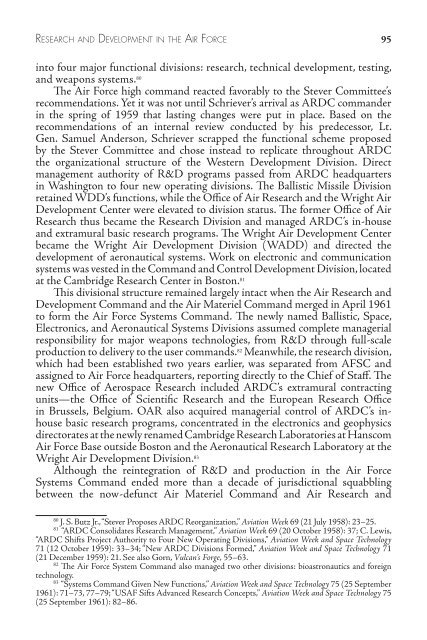To download as a PDF click here - US Army Center Of Military History
To download as a PDF click here - US Army Center Of Military History
To download as a PDF click here - US Army Center Of Military History
You also want an ePaper? Increase the reach of your titles
YUMPU automatically turns print PDFs into web optimized ePapers that Google loves.
ReseaRch a n d developmenT In T h e aIR fo R c e 95<br />
into four major functional divisions: research, technical development, testing,<br />
and weapons systems. 80<br />
The Air Force high command reacted favorably to the Stever Committee’s<br />
recommendations. Yet it w<strong>as</strong> not until Schriever’s arrival <strong>as</strong> ARDC commander<br />
in the spring of 1959 that l<strong>as</strong>ting changes were put in place. B<strong>as</strong>ed on the<br />
recommendations of an internal review conducted by his predecessor, Lt.<br />
Gen. Samuel Anderson, Schriever scrapped the functional scheme proposed<br />
by the Stever Committee and chose instead to replicate throughout ARDC<br />
the organizational structure of the Western Development Division. Direct<br />
management authority of R&D programs p<strong>as</strong>sed from ARDC headquarters<br />
in W<strong>as</strong>hington to four new operating divisions. The Ballistic Missile Division<br />
retained WDD’s functions, while the <strong>Of</strong>fice of Air Research and the Wright Air<br />
Development <strong>Center</strong> were elevated to division status. The former <strong>Of</strong>fice of Air<br />
Research thus became the Research Division and managed ARDC’s in-house<br />
and extramural b<strong>as</strong>ic research programs. The Wright Air Development <strong>Center</strong><br />
became the Wright Air Development Division (WADD) and directed the<br />
development of aeronautical systems. Work on electronic and communication<br />
systems w<strong>as</strong> vested in the Command and Control Development Division, located<br />
at the Cambridge Research <strong>Center</strong> in Boston. 81<br />
This divisional structure remained largely intact when the Air Research and<br />
Development Command and the Air Materiel Command merged in April 1961<br />
to form the Air Force Systems Command. The newly named Ballistic, Space,<br />
Electronics, and Aeronautical Systems Divisions <strong>as</strong>sumed complete managerial<br />
responsibility for major weapons technologies, from R&D through full-scale<br />
production to delivery to the user commands. 82 Meanwhile, the research division,<br />
which had been established two years earlier, w<strong>as</strong> separated from AFSC and<br />
<strong>as</strong>signed to Air Force headquarters, reporting directly to the Chief of Staff. The<br />
new <strong>Of</strong>fice of Aerospace Research included ARDC’s extramural contracting<br />
units—the <strong>Of</strong>fice of Scientific Research and the European Research <strong>Of</strong>fice<br />
in Brussels, Belgium. OAR also acquired managerial control of ARDC’s inhouse<br />
b<strong>as</strong>ic research programs, concentrated in the electronics and geophysics<br />
directorates at the newly renamed Cambridge Research Laboratories at Hanscom<br />
Air Force B<strong>as</strong>e outside Boston and the Aeronautical Research Laboratory at the<br />
Wright Air Development Division. 83<br />
Although the reintegration of R&D and production in the Air Force<br />
Systems Command ended more than a decade of jurisdictional squabbling<br />
between the now-defunct Air Materiel Command and Air Research and<br />
80 J. S. Butz Jr., “Stever Proposes ARDC Reorganization,” Aviation Week 69 (21 July 1958): 23–25.<br />
81 “ARDC Consolidates Research Management,” Aviation Week 69 (20 October 1958): 37; C. Lewis,<br />
“ARDC Shifts Project Authority to Four New Operating Divisions,” Aviation Week and Space Technology<br />
71 (12 October 1959): 33–34; “New ARDC Divisions Formed,” Aviation Week and Space Technology 71<br />
(21 December 1959): 21. See also Gorn, Vulcan’s Forge, 55–63.<br />
82 The Air Force System Command also managed two other divisions: bio<strong>as</strong>tronautics and foreign<br />
technology.<br />
83 “Systems Command Given New Functions,” Aviation Week and Space Technology 75 (25 September<br />
1961): 71–73, 77–79; “<strong>US</strong>AF Sifts Advanced Research Concepts,” Aviation Week and Space Technology 75<br />
(25 September 1961): 82–86.

















